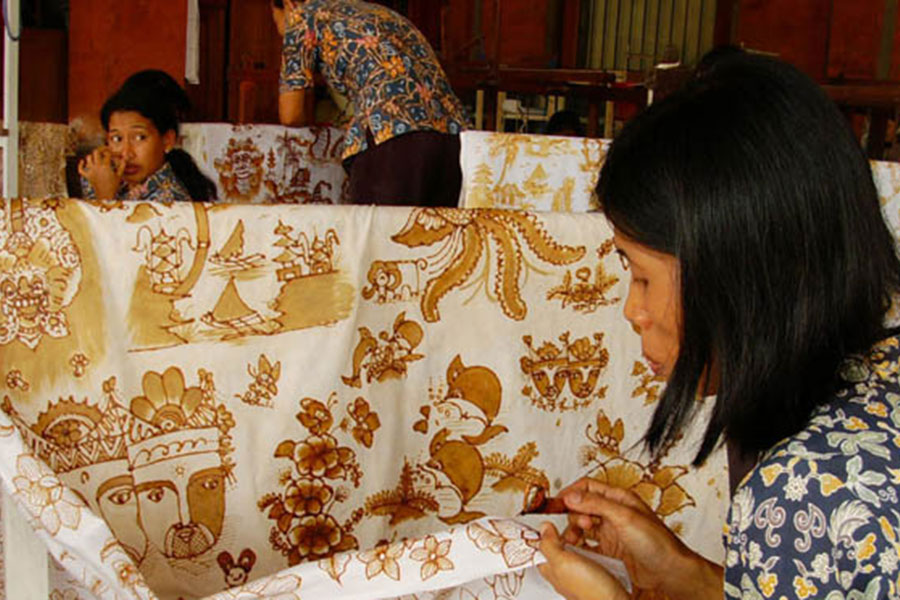TOHPATI VILLAGE
BALI TOHPATI VILLAGE IS A VILLAGE THAT FOCUSES ON BATIK CRAFTS WITH SUCH A BEAUTIFUL AND ARTISTIC DESIGN

Tohpati Batik Art Village is about 12 kilometers from Kuta and is known as the Bali Batik Wand Weaving Center. Batik is a traditional art of painting cloth where they use wax to decorate the cloth with dots and stripes. This process is very interesting to witness. When visiting or living in Indonesia, it is hard not to be exposed to the highly developed art of batik in the country. Tohpati Village is the center of the batik cottage industry, where you will have a great sensory experience through the colors, patterns, and distinctive smell of batik. With repeated visits and a little knowledge, you will begin to understand the various designs and their history. It’s an unforgettable experience while on vacation in Bali, where you can see the batik-making process, explore the batik collection, and even buy it if interested.
If you visit Batik Art at Tohpati Village, here’s what you need to know :
- What is Batik?
- History of Batik Technique
- Batik Techniques in Indonesia
- Types of Batik in Indonesia
- Tools Making Batik in Indonesia
- History of Balinese Batik
- Balinese Batik Motif
- Tohpati Village is Center of Batik Art in Bali
- What Kind of Batik are Available at Tohpati Batik Art
- Location of Tohpati Batik Art
- Facilities at Tohpati Batik Art
What is Batik?
Batik is a typical Indonesian art that involves illustrated fabrics with a very traditional and meticulous making process. It involves drawing specific shades and designs on the fabric using ink, creating dazzling lines and curves of color. On October 2nd, 2009, Batik was designated by UNESCO as the Oral and Intangible Heritage of Humanity, and since then, the date has also been designated as National Batik Day in Indonesia. This is part of the effort for generations to keep and preserve the cultural heritage, where government employees also wear batik on certain days as a sign of respect for Indonesia’s precious cultural treasures.
History of Batik Technique
Batik is a technique of dyeing cloth using wax. The craft has a long history, dating back to the 4th century BC in Egypt, where mummy-wrapped cloth was coated with wax or night to form patterns. In Asia, similar techniques were found in China during the Tang dynasty (618-907), as well as in India and Japan during the Nara period (645-794). In Africa, the Yoruba tribe in Nigeria also recognized techniques similar to batik. In Indonesia, batik is believed to have existed since the Majapahit period and became very popular in the late 17th or early 19th century. Written batik was the first to be produced, continuing until the early 20th century, while stamped batik only appeared after World War I, around 1920. Although the word “batik” comes from the Indonesian Javanese language, the exact history of the origin of batik is not clearly recorded. Some scholars argue that the batik technique may have been introduced from India or Sri Lanka in the 6th and 7th centuries, while others believe that the batik tradition originated in regions such as Toraja, Flores, Halmahera, and Papua in Indonesia, which have ancient traditions of batik-making despite not being influenced by Hinduism.
Batik Techniques in Indonesia
The oldest batik art found in Indonesia emerged in the 17th and 18th centuries, during the reign of the Majapahit kingdom. At first, batik was only used by people in the palace and their followers. However, over time, the art of batik spread outside the palace and became clothing that was also used by the general public. Interestingly, batik motifs on cloth are not only limited to clothing but are also seen on the reliefs of the Prambanan and Borobudur temples. This finding shows that batik has existed in Indonesia since ancient times and is not an inheritance from India. Nonetheless, the origin of the batik technique in Indonesia is still a mystery that has not been fully solved. The question of whether batik is an indigenous Indonesian craft or was introduced by outsiders is still a big question mark, and it requires further research to provide a definitive answer regarding the origin of batik in Indonesia.
Types of Batik in Indonesia
The types of batik vary greatly and have developed over time, resulting in a very diverse range of batik types. All these types of batik retain their distinctive characteristics, namely painting on cloth with motifs and colors, which used to be limited to black and white but now have a variety of colors thanks to the times and variations in coloring. In the past, batik coloring only recognized a few colors. The art of batik is very beautiful and is part of the cultural heritage that is still maintained by batik craftsmen in Indonesia. Some of the known types of batik include:
- Batik Tulis (Written Batik): This is a type of batik that first existed and was used during the royal era with manual making techniques using hands and canting to paint motifs on the cloth. The price of written batik is relatively high due to its unique and manual process.
- Batik Cap (Batik Stamp): This type of batik is made using a stamp or stamp with a specific batik motif instead of canting. This stamp is usually made of copper and engraved with a certain motif, then stamped onto the cloth. This process is faster and more efficient in production.
- Batik Cetak (Batik Printing): This is a modern type of batik that uses screen printing technology for its production, resulting in large quantities in a short period of time, often sold at affordable prices in clothing stores, supermarkets, and markets.
- Batik Kombinasi (Combination Batik): This type of batik combines the techniques of both written and stamped batik, where the missing parts of stamped batik are complemented by the techniques of written batik. The manufacturing process is more complicated, and the price tends to be higher, but it produces a more exclusive batik.
Tools Making Batik in Indonesia
The tools and materials used in making batik are of various types. Although the process of making batik is not very complicated, the most difficult part is the painting process. It requires excellent painting skills to create a pattern similar to the desired one. This skill is similar to painting on canvas, requiring a high level of patience and focused concentration. Mistakes in painting cannot be erased, as the ink is permanent. If a mistake is made, the process must be started all over again with new materials. Because of this, batik often comes at a high price due to the process and skill required in making it.
- Lilin Malam (wax) is used as a barrier in batik art to prevent the color liquid from sticking to the mori cloth covered with wax, so that after the wax removal process, the cloth retains its white color. Night wax is heated using a stove flame in a container, such as a small pan.
- Canting is a tool used to create written batik patterns, similar to a pen in regular painting, while the wax acts as ink. The melted wax is then placed in the canting, which has a tube that stores the wax and is used to draw the desired batik pattern.
- Gawangan is a wooden or bamboo-shaped tool used to place the mori cloth to be painted. This facilitates the process of painting the desired batik pattern because the cloth can be positioned stably on the gawangan.
- Canting Cap is a tool used in the stamped batik technique, made of copper with a predetermined pattern. Each canting cap has only one pattern, where the pattern is engraved and printed on the cloth.
- Mori cloth is a special type of cloth used in batik making. Made from cotton, this mori fabric is chosen because it is suitable for the batik process, unlike ordinary clothing fabrics.
- Pewarna (Dye) is a color substance used to give color to batik paintings. There are two types of dyes, namely natural dyes derived from natural materials such as leaves, bark, fruit tubers, and fruit peels, and synthetic dyes made from chemicals to create certain colors.
History of Balinese Batik
The technique for making batik in Indonesia is the same. The difference is the painting motif. Bali Island has a distinctive motif that distinguishes it from other regions. The development of Balinese batik is very rapid due to high market demand, especially from foreign tourists who buy batik as souvenirs of Bali. Initially, Balinese people made batik with hereditary patterns or their own creations, which characterized their batik products. Initially, batik making in Bali was done in groups with traditional hand-written batik techniques that took a long time and were inefficient to meet the high demand. However, in 1970, Pande Ketut Khrisna introduced the stamp technique with traditional equipment, which accelerated the production of Balinese batik. Many entrepreneurs then opened specialty Balinese batik shops in Tohpati village, located on the main road to Ubud. Tohpati village is now known as Tohpati Batik Art Village, making it an attractive place for tourists who want to see the unique craft of batik in Bali. Its strategic location on the tourist route makes it easily accessible to tourists heading to Ubud.
Balinese Batik Motif
Batik is part of Indonesia’s cultural heritage that continues to be preserved in all regions, including Bali. The difference between Balinese batik and batik from other regions lies in the motifs used. Balinese batik has its own characteristics, namely complex and aesthetic images, not only limited to line patterns or floral motifs but also including images of puppets and mythical animals. The process of making this batik uses a very complicated hand-drawn batik technique and requires a high level of skill in designing the pattern on the cloth before it is painted. Some of the motifs that characterize Balinese batik include:
- Singo Barong: This batik motif depicts the distinctive Barong headdress, complete with a grin and sharp fangs, creating the fearsome appearance of the mythical creature Barong. When combined with the fabric, this motif becomes an enchanting and beautiful piece.
- Bouquet: This motif features a variety of floral patterns, depicting a beautiful collection of flowers in various sizes, especially small flowers with beautiful colors.
- Balinese dancer: This motif depicts an elegant Balinese dancer on a mori cloth with painted dance moves, reflecting the distinctive characteristics of the island of Bali.
- Ulamsari: This motif depicts marine flora and fauna, especially small leaves with attractive stalks, giving it a sweet and unique touch, accompanied by striking colors that are of interest to teenagers.
- Abyor Hokokai: This motif is a fusion of Japanese culture influencing batik art, combined with the iconic peacock ornament and beautiful foliage.
- Pisan Bali: This motif has beautiful curves that are often used as gifts for couples who are traveling, wishing them safety and happiness.
Tohpati Village is Center of Batik Art in Bali
Tohpati Village is the place in Bali that first introduced the process of batik-making. Initially, there was a shop in the village that introduced the art of batik-making to foreign tourists. The very positive response from tourists to this batik craft led many entrepreneurs to open batik craft shops in Tohpati. This made Tohpati the center of batik art crafts in Bali. Along the streets of Tohpati village, you will find many batik craft shops on both sides of the road. With affordable prices and good-quality products, Tohpati Village has become more and more famous for its batik over the years. If you are looking for batik while on vacation in Bali, then Tohpati Village is the place to be. The village is already very famous for its batik crafts. You can find various types of batik, including hand-written batik, which is a very complicated and difficult process to make. Tohpati Village also accepts special orders with specific patterns. You can see in detail the process of making batik from scratch here. In addition, hand-written batik works are also displayed in galleries and sold to tourists who want to bring home Balinese souvenirs in the form of batik clothes.
What Kind of Batik are Available at Tohpati Batik Art
Batik crafts in Tohpati Batik Art Village offer a variety of choices. Batik itself is an art craft of painting cloth with a very beautiful pattern, and this batik cloth is not only used for clothing but can also be used for various other works. In Tohpati, you can find a variety of products, such as batik shirts, batik bags, batik wallets, and so on. In addition, they also accept customized orders using batik materials. In addition to the diversity of batik products, you can also see Balinese motifs that characterize batik on this island. For lovers of cultural tourism, a visit to Tohpati Batik Art Village is the right choice. You can enjoy beautiful cultural art with amazing skills. This outstanding work has increased the interest of tourists, both foreign and domestic, in learning more about the art of batik and the richness of Balinese culture as a whole.
Location of Tohpati Batik Art
The location of Tohpati Batik Art Village is close to Batubulan Village, just before the Batubulan bus terminal in Tohpati Village, Batubulan District, Bali. From Kuta or Seminyak, it takes about 45 minutes to get there. If you want to go by yourself, you can use Google Maps to reach Tohpati Batik Art. However, if you don’t want to bother, you can utilize the services of Bali Driver Hire, which provides Hire Car and Driver with affordable prices and satisfying services. Using a comfortable car with an experienced driver will make this trip enjoyable. If you are a lover of fabric art, batik art in Tohpati is the right choice, as it is part of Indonesia’s craft art.
Facilities at Tohpati Batik Art
The facilities available in Tohpati Village are very complete, especially since the village is known as one of the batik cultural tourism centers in Bali. If you visit Tohpati Village, you can enjoy the various batik arts available here. Tohpati Batik Art provides complete facilities, from a place to see the process of making hand-written batik to a gallery displaying the hand-written batik produced here. You will be guided by a batik attendant who explains the batik-making process from start to finish. The gallery displays the results of batik with very artistic shapes and patterns, sure to impress you with the uniqueness of this batik. Visiting one of the Gianyar places of interest in Tohpati Village is a memorable experience because you can see Indonesia’s cultural heritage, which is recognized by UNESCO as part of Indonesia’s cultural characteristics. If you are visiting Indonesia, don’t miss out on buying batik, which is a symbol of Indonesia’s cultural attire.

